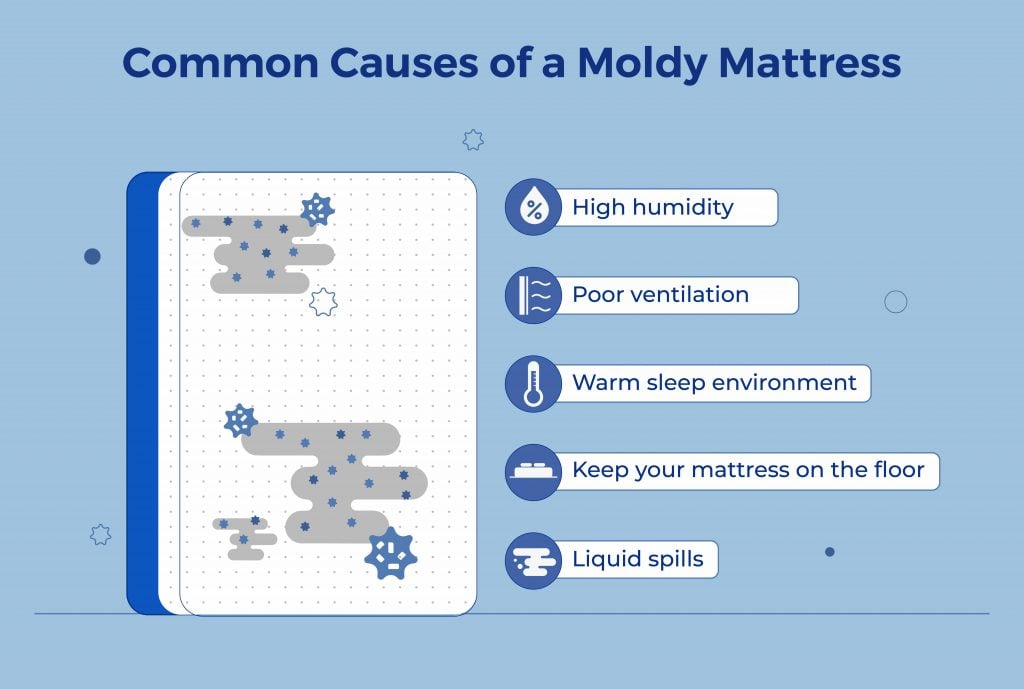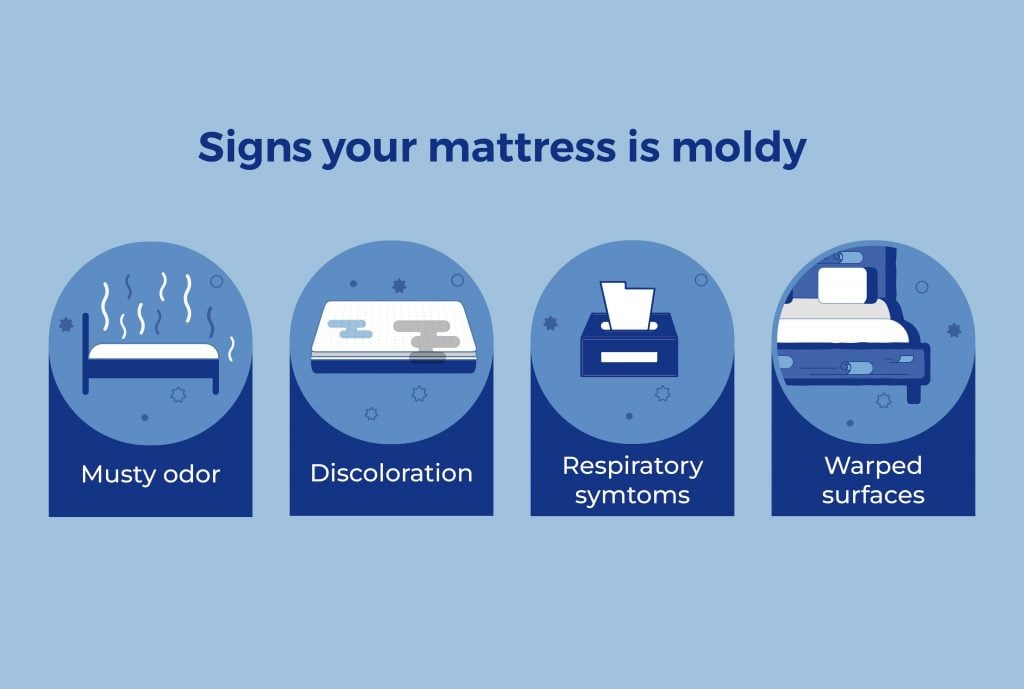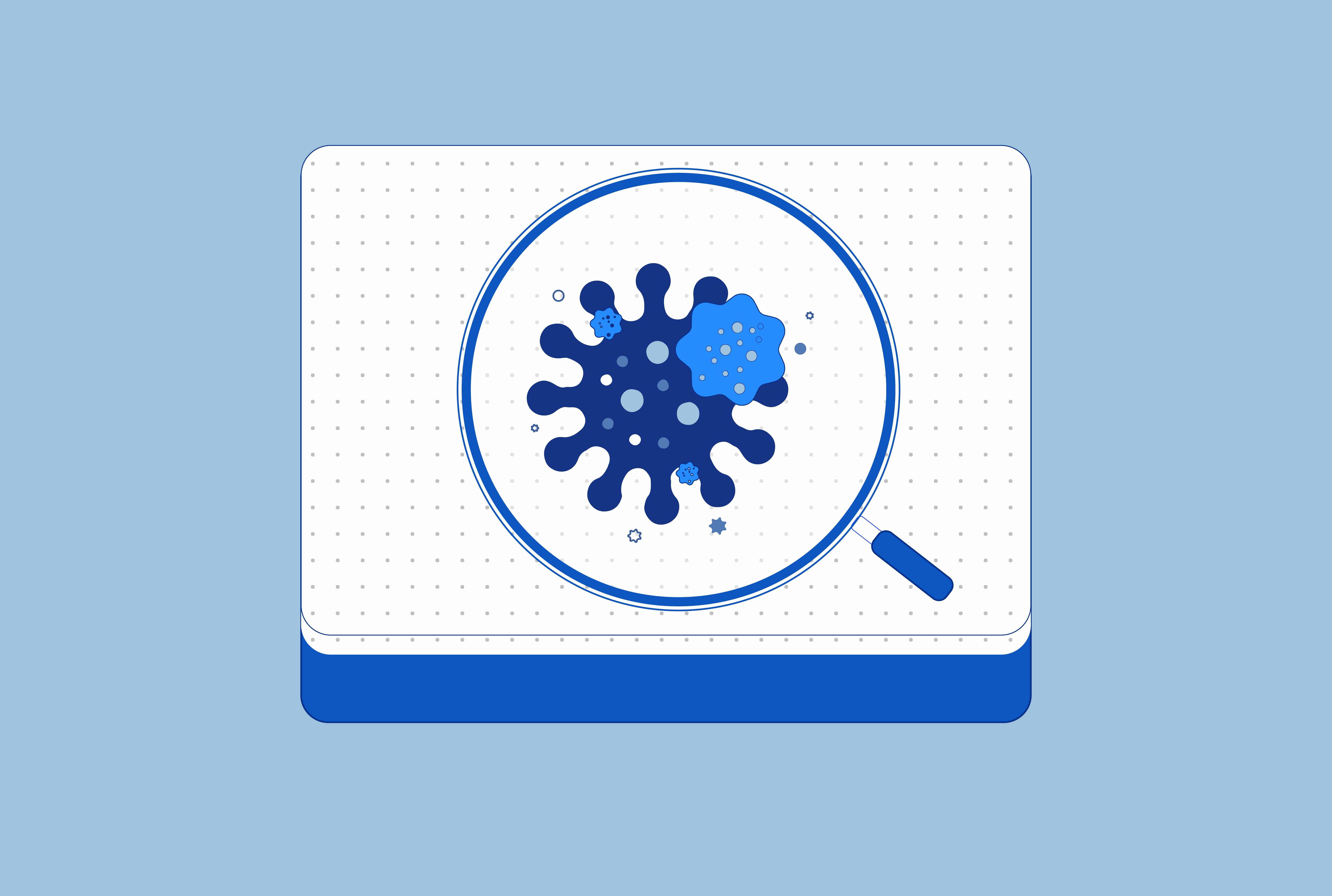Key Takeaways
- Identifying Mold on a Mattress: Mold on a mattress can manifest as visible black, green, or white spots with a fuzzy texture. Checking for signs of mold involves examining the entire mattress surface, including corners, edges, and under the mattress cover. Musty odors and stains on the mattress can also indicate mold growth. Prompt action is essential to prevent further spread if mold is detected.
- Detecting Hidden Mold and Health Effects: Even if mold isn’t visible on the mattress surface, it could still be present and affect health. Invisible mold can be identified by its musty odor or by observing allergy symptoms like sneezing and coughing. Mold can spread quickly and lead to serious health issues, necessitating investigation and immediate action if symptoms arise.
- Mold Prevention and Removal: To prevent mold, maintain a dry and well-ventilated sleep environment, use hypoallergenic mattress protectors, wash bedding regularly, and avoid eating in bed. If mold is severe or there are health concerns, consult a professional for mold remediation.
Mold on a mattress can be a serious problem that not only affects the quality of your sleep but also poses a risk to your health. Mold growth can cause respiratory problems, allergies, and other health issues, making it crucial to address the issue as soon as possible.
In this article, we’ll discuss how to spot mold on a mattress and what to do about it.
Quick Guide: A 30-Second Summary
| Best Mold-Resistant Mattress | Amerisleep Organica |
Signs of Mold on a Mattress
Mold on a mattress can often be identified by visible signs such as black, green, or white spots. These spots can appear anywhere on the mattress, including the top, sides, and bottom. It also has a fuzzy texture.
To check for visible mold, remove all bedding and inspect the mattress surface carefully. Pay attention to the corners and edges where mold tends to grow.
It’s essential to check under the mattress cover and between the layers, where mold Verified Source Environmental Protection Agency (EPA) Works to control/prevent natural and manmade disasters. View source can grow undetected. Additionally, if you notice a musty smell or stains on your mattress, it could be an indication of mold growth. If you see any signs of mold growth, take action immediately to prevent it from spreading.
What If I Can’t See Mold in My Mattress?
 Even if mold is not visible on the surface, it can still be present on the mattress. Invisible mold can be identified by its musty odor or stains on the mattress surface. Mold exposure can cause
allergy symptoms,
Verified Source
Medline Plus
Online resource offered by the National Library of Medicine and part of the National Institutes of Health.
View source
such as sneezing, runny nose, and coughing, even if it is not visible.
Even if mold is not visible on the surface, it can still be present on the mattress. Invisible mold can be identified by its musty odor or stains on the mattress surface. Mold exposure can cause
allergy symptoms,
Verified Source
Medline Plus
Online resource offered by the National Library of Medicine and part of the National Institutes of Health.
View source
such as sneezing, runny nose, and coughing, even if it is not visible.
It is crucial to take action even if mold is not visible on the mattress surface. Mold can spread quickly and cause health problems, including the aforementioned allergy symptoms. If you notice these symptoms while sleeping on your mattress and suspect mold growth, it’s time to investigate further.
Differences Between Mold and Mildew
It’s important to note that mold and mildew are different types of fungi that can grow in damp environments. While they may look similar, they have different characteristics and effects on health. Mildew is a surface fungus that grows on damp surfaces, while mold can penetrate deeper into surfaces.
Mildew is typically white or gray and has a powdery appearance. It grows on organic materials such as fabrics and paper. Mildew is generally not as harmful as mold and can be removed with a simple cleaning solution.
Mold, on the other hand, can be various colors including green, black, brown, or white. It is a type of fungus that grows in colonies and can penetrate deep into porous materials such as mattresses, walls, and ceilings. Mold can cause serious health problems and should be removed as soon as possible.
“Additionally, those who live in certain geographic locations are more likely to be exposed to specific types of spore-forming mold,” says Antrell Cheatom.
“For example, Histoplasma capsulatum is a highly pathogenic fungus typically found in the Mississippi and Ohio river valleys. It is capable of causing severe respiratory disease in those who are immunocompromised. However, there was a relatively recent case Verified Source National Library of Medicine (NIH) World’s largest medical library, making biomedical data and information more accessible. View source where a Central Californian suffered from exposure to this pathogen, illustrating the need to not generalize and underestimate potential health risks.”

What Causes Mold on a Mattress?
Mold growth on a mattress can be caused by several factors, including humidity, moisture, and poor airflow. When moisture accumulates on the mattress, it provides a perfect breeding ground for mold spores. Poor airflow can also contribute to mold growth, as it prevents a damp mattress from drying out.
To reduce the risk of mold growth on a mattress, it is important to keep the sleep environment dry and well-ventilated for better air quality. Use a dehumidifier to reduce humidity levels as needed, and keep the room cool.
“Cooler temperatures slow fungal metabolism which facilitates a lower likelihood for pathogenesis,” explains Antrell Cheatom. “Certain compounds in the immune system called “proteases” heavily contribute to the body’s allergic reactions, including mold allergies.
“ A recent study Verified Source National Library of Medicine (NIH) World’s largest medical library, making biomedical data and information more accessible. View source from an Allergy and Immunology journal, Front Allergy, stated that “numerous major allergens, including HDM, pollen, cockroaches, fungi, and some fruits, contain protease activity.”

How Can I Remove Mold From a Mattress?
If you suspect mold is growing on your mattress, it’s important to take immediate action to remove it. Leaving mold untreated can cause serious health problems and further damage your mattress. Here’s how you can remove mold by cleaning your mattress.
Cleaning solutions include vinegar, rubbing alcohol, or hydrogen peroxide mixed with water, all effective at killing mold on mattresses. Regardless of what cleaning solution you use, protect yourself by wearing gloves, a mask, and eye protection such as safety goggles. This will prevent you from inhaling mold spores and coming into direct contact with the contaminated material. If you can, open the bedroom’s windows to better ventilate the room.
Note: If the mold on your mattress is severe, or you have any health issues such as allergies or asthma, it’s recommended to consult a professional mold remediation service for proper cleaning and removal.
Removing Mattress Mold with Vinegar
- Remove all bedding and wash it in hot water with a detergent and a cup of vinegar. This will kill any mold spores on the fabric.
- Vacuum the mattress thoroughly to remove any loose mold spores.
- Mix a solution of equal parts white vinegar and water. Spray this solution on the affected areas of the mattress and let it sit for an hour. This will kill any remaining mold spores.
- Use a clean towel to blot up any excess moisture from the mattress.
- Allow the mattress to air dry completely in a well-ventilated area. Make sure it is completely dry before putting the bedding back on. You may wish to run the vacuum over the entire mattress once it’s dry as a final precaution.
Removing Mattress Mold with Rubbing Alcohol
- Mix rubbing alcohol (at least 70% concentration) and warm water in a 1:1 ratio and pour it into a spray bottle. Alternatively, mix it into a bowl and saturate a clean clean cloth with the solution.
- Spray the solution directly or use the damp cloth to sop it onto the mold-affected areas of the mattress, making sure to saturate the mold thoroughly.
- Let the solution sit on the mold for 10 to 15 minutes to penetrate and kill the spores.
- Using a clean cloth or sponge with the rubbing alcohol solution, gently scrub the moldy areas in a circular motion. Be careful not to damage the fabric or push the mold deeper into the mattress.
- Allow the mattress to air dry completely before covering it with clean sheets.
- Once the mattress is dry, vacuum it thoroughly to remove any remaining spores or debris.
Removing Mattress Mold with Hydrogen Peroxide
Note: It’s essential to use hydrogen peroxide with caution, as it can bleach or discolor some fabrics. Test the solution on a small, inconspicuous area of the mattress first to ensure it doesn’t cause any damage.
- Pour one part hydrogen peroxide to three parts water into a spray bottle. Or mix these into a bowl and dip a cleaning brush into the solution.
- Spray the solution or scrub it with the brush directly onto the mold-affected areas of the mattress, making sure to saturate the mold thoroughly. Go beyond the edges of the mold to target any invisible growth.
- Let the solution sit on the mold for 10 to 15 minutes to penetrate and kill the spores.
- Using a clean cloth or sponge, gently scrub the moldy areas, being careful not to damage the fabric or push the mold deeper into the mattress.
- Allow the mattress to air dry completely before covering it with clean sheets.
Should I Replace a Moldy Mattress?
 In some cases, it may not be possible to remove all the mold from a mattress, especially if it has penetrated deep into the material. If this is the case, it’s best to replace the mattress with a new one. This is particularly important if you or someone in your household suffers from respiratory problems or allergies.
In some cases, it may not be possible to remove all the mold from a mattress, especially if it has penetrated deep into the material. If this is the case, it’s best to replace the mattress with a new one. This is particularly important if you or someone in your household suffers from respiratory problems or allergies.
It’s also worth noting that opening up the mattress cover to clean or examine it for mold can release fiberglass particles, another respiratory irritant. Fiberglass is common in many mattresses, and you may not know whether or not you have a mattress without fiberglass.
So even if you can remove the cover to check for mold in the mattress’s materials, you may still put your health in danger. This is why we always recommend sleeping on a fiberglass-free mattress.
If you have a moldy mattress that you simply want to toss, there are several ways to get rid of a mattress. Check with your local waste management company to see if they offer mattress pick-up or disposal services. They may have specific requirements for how to prepare the mattress for disposal, such as wrapping it in plastic.
While mattress recycling is important, a moldy mattress may not be accepted by recycling centers. Because of the dangers of mold spores and hidden mold, we also advise against upcycling a moldy mattress.
How to Prevent Mold on Mattresses
Preventing mold growth on your mattress is the best way to keep your space clean and healthy. Here are some tips to help you prevent mold growth on your mattress:
- Use a hypoallergenic mattress protector. These covers are designed to keep moisture out and prevent mold growth.
- Wash your sheets and other bedding regularly in hot water to kill any mold spores.
- Avoid eating or drinking in bed. This can lead to spills and moisture, which can promote mold growth.
- Similarly, avoid sleeping with wet hair. Moisture may seep not only into your pillow, but into the mattress itself.
- Keep your bedroom well-ventilated. Sleep with a fan on or open windows during the day to promote air circulation.
- Routine cleaning and freshening up a mattress can help prevent mold growth. Vacuum the mattress regularly, and clean any spills or stains immediately.
- Consider the benefits of an air purifier or dehumidifier. An air purifier clears the air of allergens like mold spores while a dehumidifier reduces humidity levels in your bedroom.
- Make sure to check your mattress monthly for signs of mold growth, such as musty odors, stains, or discoloration, particularly in a basement bedroom. If you detect any mold, take immediate action to remove it.
- Do not stack a mattress on top of a mattress, as this can not only cause significant comfort issues but restrict airflow and increase the chances of mold growth.
- Be careful with plants in the bedroom and around the home. While there are many benefits to keeping plants in the bedroom, a bedroom plant can raise humidity levels and enable mold growth, particularly if the plant is overwatered.
- Replace your mattress every 8 to 10 years to prevent the buildup of mold and other allergens.

More to Keep Out of the Bedroom
Mold isn’t all that can make a home in your bedroom, as you’ll want to keep various pests from settling in your bed and walls. Such pests can affect your health and the structure of your home:
- What Attracts Bed Bugs and How to Prevent Them
- How to Get Rid of Bed Bugs in a Mattress
- What Do Bed Bugs Look Like?
- Signs You Have Fleas in Your Bed
- Should I Be Concerned About a Tick in Bed?
- Should I Be Concerned About a Silverfish in Bed?
- How to Keep Centipedes Out of Your Bed
- Can Termites Get in My Bed?
- How To Treat Your Mattress For Lice
- How to Get Rid of Ants in Your Bed
- How to Get Rid of Scabies From Mattress
- How to Keep Spiders out of the Bedroom
- How to Keep Cockroaches out of the Bedroom
- How to Get Rid of Mosquitos in the Bedroom
- How to Keep Mice Out of Your Bed
- What to Do if a Bat Gets into Your Bedroom?
Frequently Asked Questions
Can you sleep on a moldy mattress?
No, sleeping on a moldy mattress is a bad idea due to the potential health risks associated with mold exposure. Mold can release spores that can irritate your respiratory system and cause allergic reactions, along with other health issues. It’s best to make sure your sleeping space is free of mold, whether through deep cleaning or a thorough replacement of moldy bedding.
How can you tell if your mattress has mold?
Visible mold growth on the mattress is the most apparent sign of its presence. Look for black, green, or white spots on the mattress.
However, mold can also be present without visible signs. It’s important to check for musty odors and other mattress smells, discoloration, or stains on the mattress. Particularly discoloration that changes and spreads. If you notice any of these signs, it’s recommended to take action and clean or toss the mattress.
How can I prevent mold growth on my mattress?
Regular mattress maintenance can help prevent mold growth. Using a mattress protector or other cover prevents moisture from getting into the mattress. Additionally, keeping the bedroom well-ventilated, using dehumidifiers and air purifiers to reduce humidity and eliminate airborne allergens, and cleaning the mattress monthly can help prevent mold growth.
Can I get mold out of a mattress, or do I need to replace it?
It’s challenging to remove mold from a mattress entirely, particularly if it has penetrated through the surface. Some cleaning techniques can help remove surface mold, though you’ll still need to keep an eye on the mattress to make sure the mold doesn’t return.
This is why it’s often best to replace the mattress with a new mold-resistant and hypoallergenic model to ensure a healthy sleeping environment.
Are certain types of mattresses more mold-resistant than others?
Latex mattresses are often prized as the best at resisting mold growth. Latex is inherently antimicrobial and hypoallergenic, making it resistant to mold, mildew, and dust mites. Many latex mattresses are also aerated, and proper air flow helps to prevent the buildup of moisture that can lead to mold growth.
When it comes to mold resistance foams, latex is better than memory foam. However, any mattress can develop mold growth if it is exposed to high humidity or moisture levels. Regular maintenance and preventive measures can help reduce the risk of mold growth regardless of the mattress type.
Conclusion
Mold growth on a mattress and mold in the bedroom can cause health problems and affect the quality of sleep. It is important to identify the signs of mold growth on a mattress, which include visible black, green, or white spots, a musty odor, or spreading stains on the mattress surface. It’s also crucial to understand the factors that promote mold growth, such as a humid environment.
Sleepers should take mattress mold seriously because mold can penetrate deep into porous materials and cause serious health problems. To prevent mold growth, it is crucial to keep the sleep environment dry and well-ventilated.
Removing mold from a mattress requires protective gear and a cleaning solution, such as vinegar, rubbing alcohol, or hydrogen peroxide. In severe cases, it is recommended to consult a professional mold remediation service for proper cleaning and removal, or to toss the old mattress and replace it with a new mold-resistant mattress.
About the author
Geoff McKinnen is a writer focusing mainly on the healthcare industry and has written articles on everything from foods to help you lose weight to the connection between Alzheimer’s and sleep. Geoff’s passionate about helping readers improve their well-being to lead happier lives. Outside of work, Geoff enjoys cycling and hiking and believes that by leading a healthy lifestyle, he can help others do the same.
View all posts





